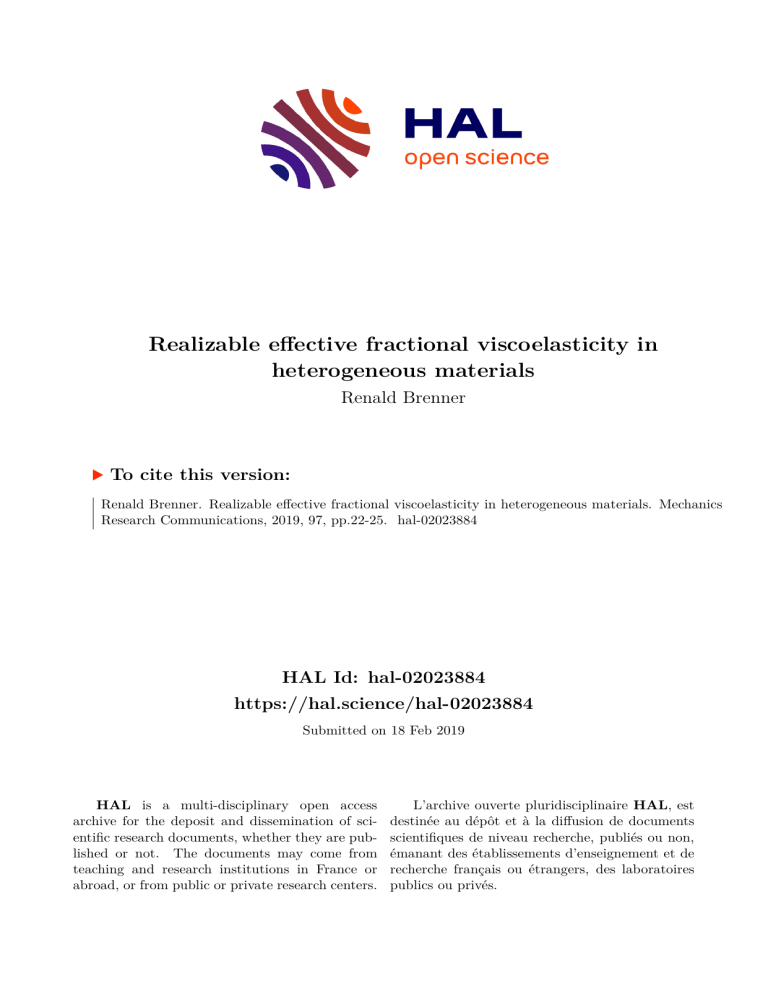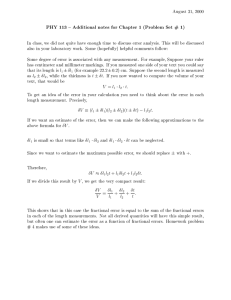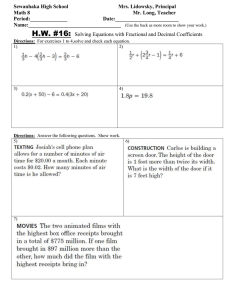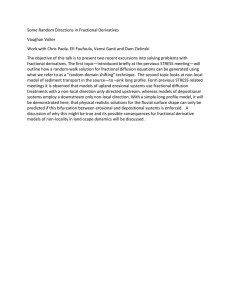
Realizable effective fractional viscoelasticity in heterogeneous materials Renald Brenner To cite this version: Renald Brenner. Realizable effective fractional viscoelasticity in heterogeneous materials. Mechanics Research Communications, 2019, 97, pp.22-25. �hal-02023884� HAL Id: hal-02023884 https://hal.science/hal-02023884 Submitted on 18 Feb 2019 HAL is a multi-disciplinary open access archive for the deposit and dissemination of scientific research documents, whether they are published or not. The documents may come from teaching and research institutions in France or abroad, or from public or private research centers. L’archive ouverte pluridisciplinaire HAL, est destinée au dépôt et à la diffusion de documents scientifiques de niveau recherche, publiés ou non, émanant des établissements d’enseignement et de recherche français ou étrangers, des laboratoires publics ou privés. Realizable effective fractional viscoelasticity in heterogeneous materials R. Brenner Sorbonne Université, CNRS, Institut Jean le Rond ∂’Alembert, F-75005 Paris, France Abstract This note addresses the overall viscoelastic behaviour of composite materials made of elastic and viscous phases. By considering different microstructures, it is shown that classical or fractional viscoelasticity can be achieved. Hierarchical checkerboard microstructures are proposed to build fractional viscoelastic materials. 1. Introduction Fractional calculus has proven to be very efficient to model the viscoelastic constitutive response of several materials. For a creep loading, for instance, it allows to describe a nonlinear time dependence of the strain which is observed, inter alia, in polymers, rocks and ice polycrystals α t ε(t) ∝ , 0 < α < 1. (1) τ Such experimental evidence dates back to the beginning of the twentieth century [13, 5]. An overview of empirical fractional viscoelastic models can be found in [8, 9]. The first attempt to relate the fractional behaviour to the material’s composition is the study of Bagley and Torvik [1] who showed that the molecular theory describing the polymer chain dynamics (Rouse model) was in fact a fractional viscoelastic model of order 1/2. Rheological models with a fractal arrangement of classical elastic and dashpot elements have also been proposed to obtain fractional response without reference to a real material microstructure [15, 7]. Deseri et al. [3] have proposed to relate explicitly the fractional response to the fractal scaling of bone material microstructure. This question has also been recently addressed in the context of continuum micromechanics by a numerical study on a 2D viscoelastic material made of an elastic constituent and a Zener constituent [14]. However, the possible emergence of a fractional viscoelastic behaviour resulting from microstructural features of the material remains an open question. To tackle this problem, we consider two-phase 2D composite materials with purely elastic and viscous phases. This is the simplest assumption on the local constitutive behaviours to get an overall viscoelastic response. The purpose of this short note is to provide examples of microstructures leading to classical or Email address: renald.brenner@sorbonne-universite.fr (R. Brenner) Preprint submitted to Mech. Res. Comm. fractional viscoelasticity. It makes a contribution towards the determination of the yet unknown set of achievable viscoelastic behaviours. 2. Problem studied We consider the steady-state response of 2D two-phase composite materials (i.e columnar microstructure) with overall transverse isotropy which are subjected to a sinusoidal strain loading. The phases are assumed isotropic and incompressible. One of the two is purely elastic (phase 1) while the other is purely viscous (phase 2). The local harmonic response is thus characterized by real and imaginary shear moduli, that is µ1 = µe and µ2 = ıωµv (2) with ı2 = −1 and ω the angular frequency. Besides, we define the time τ = µv /µe . The volume fraction of phase (i) is denoted ci . In the following, attention is restricted to the estimate of the effective transverse shear modulus µ e(ıω) in the steady-state harmonic regime. 3. Hashin-Shtrikman and self-consistent estimates of transverse shear modulus Let us consider the Hashin-Shtrikman estimates of the overall shear modulus by choosing respectively phase (1) or (2) as reference material µ2 − µ1 µ2 − µ1 , 1 + c1 2µ1 µ2 − µ1 = µ1 + c2 µ2 − µ1 . 1 + c1 µ2 + µ1 µ eHS1 = µ1 + c2 µ eHS2 (3) It is noted that these expressions provide well-known bounds in the context of elasticity. This is not the case here since February 18, 2019 the overall shear modulus has complex value1 . However, the estimates (3) remain achievable by a specific class of particulate microstructures obtained by sequential lamination [4, 12]. The purely viscous asymptotic regimes are defined by 1 0 1 0 eHS2 (ω) = lim µ eHS2 (ω) = 0, lim µ ω→+∞ ω ω→0 ω With the local shear moduli (2), we get, on one hand, ∀ c1 6= 0, 1 00 µe τ (ω) = µ e . ω HS2 f (c2 ) (10) Also, the condition lim (1/ω)e µ00HS2 (ω) ≥ lim (1/ω)e µ00HS2 (ω) 1 00 lim µ eHS2 (ω) = µe τ f (c2 ), ω→0 ω µe ıω τ1 1 µ eHS1 (ıω) = + µe f (c1 ) − f (c1 ) 1 + ıωτ1 f (c1 ) with τ1 = τ f (c1 ) and f (c) = 2−c . (4) c Two types of viscoelastic overall behaviour are thus realizable by hierarchical laminate microstructures with purely elastic and viscous phases, namely Zener and anti-Zener models. For a given Hashin-Shtrikman estimate, the type of effective viscoelasticity is independent of the (non-null) volume fractions of the phase. µe 1 + ω 2 τ12 f (c1 )2 , f (c1 ) 1 + ω 2 τ12 (5) µ e00HS1 (ω) = 2 µe ω τ1 (f (c1 ) − 1) . f (c1 ) 1 + ω 2 τ12 Another realizable homogenization scheme is the self-consistent estimate (aka. effective medium or coherent potential approximation). The corresponding 2D microstructure consists of circular grains with an infinite range of length scales [11]. It reads The purely elastic asymptotic regimes are defined by lim µ e00HS1 (ω) = lim µ e00HS1 (ω) = 0, ω→+∞ ω→0 lim ω→0 µ e0HS1 (ω) µe , = f (c1 ) (6) lim ω→+∞ µ e0HS1 (ω) Note that the condition lim µ e0HS1 (ω) ≤ ω→0 = µe f (c1 ). µ eSC = lim µ e0HS1 (ω), i p 1h ∆c ∆µ + (∆c ∆µ)2 + 4µ1 µ2 2 with ∆c = c1 − c2 ω→+∞ which stems from the Clausius Duhem inequality, is met since f (c1 ) ≥ 1. Besides, the viscous moduli ηev characterizing the transient regime of the Zener model is given by 1 ηev = µe τ 1 − . (7) f (c1 )2 and ∆µ = µ1 − µ2 . (12) This model presents a percolation threshold at ∆c = 0. With (2), we get an effective complex viscoelastic shear moduli 1h µ eSC (ıω) = µe ∆c (1 − ıωτ )+ 2 i p (µe ∆c)2 (1 − ω 2 τ 2 ) + ıωτ µ2e (4 − 2(∆c)2 ) . (13) On the other hand, we have, ∀ c2 6= 0, The corresponding storage and loss moduli take the form ıω τ2 µe τ 1 + µe 1 − µ eHS2 (ıω) = ıω f (c2 ) 1 + ıωτ2 f (c2 )2 with ω→+∞ ω→0 is verified since f (c2 ) ≥ 1. The elastic moduli ηee specifying the transient state of the anti-Zener model reads 1 ηee = µe 1 − . (11) f (c2 )2 This estimate defines an overall Zener behaviour whose storage and loss moduli read µ e0HS1 (ω) = lim ω→+∞ µe h 1 µ e0SC (ω) = ∆c + √ 2 2 qp (∆c)4 (1 + ω 2 τ 2 )2 + 16 ω 2 τ 2 (1 − (∆c)2 )+ τ2 = τ f (c2 ). (8) Conversely, this estimate thus defines an anti-Zener effective behaviour [10] with storage and loss moduli 1 ω 2 τ22 µ e0HS2 (ω) = µe 1 − , 2 f (c2 ) 1 + ω 2 τ22 (9) 2 2 2 µe ω τ2 f (c2 ) + ω τ2 µ e00HS2 (ω) = . f (c2 )2 1 + ω 2 τ22 i (∆c)2 (1 − ω 2 τ 2 ) , µ e00SC (ω) = qp 1 For a comprehensive study on bounds in this context, the reader is referred to [6] which makes use of a variational principle for complex viscoelasticity derived in [2]. µe h 1 − ωτ ∆c + √ 2 2 (∆c)4 (1 + ω 2 τ 2 )2 + 16 ω 2 τ 2 (1 − (∆c)2 )− i (∆c)2 (1 − ω 2 τ 2 ) . (14) By contrast with the Hashin-Shtrikman estimates (4) and (8), the type of viscoelasticity described by the self-consistent model depends on the volume fraction of the phases: 2 • ∆c > 0 When the elastic phase is predominant, the asymptotic regimes are purely elastic with lim µ e00SC (ω) = lim µ e00SC (ω) = 0, ω→0 ω→+∞ (15) µe 0 0 lim µ eSC (ω) = µe ∆c, lim µ eSC (ω) = . ω→+∞ ω→0 ∆c which fulfill the requirement lim µ e0HS1 (ω) ≤ lim µ e0HS1 (ω). ω→+∞ ω→0 Note that the overall transient regime between the two elastic states is not described by a Zener model contrary to the Hashin-Shtrikman estimates (4). • ∆c < 0 Figure 1: An example of hierarchical checkerboard at step (2) In this case, the viscous phase is predominant and the asymptotic regimes are purely viscous 1 0 1 0 lim µ e (ω) = lim µ eSC (ω) = 0, ω→0 ω SC ω→+∞ ω 1 00 µe τ lim µ eSC (ω) = , ω→0 ω ∆c with lim (1/ω)e µ00SC (ω) ≥ ω→0 4. Hierarchical checkerboard microstructures The self-consistent estimate for a two-phase mixture with equal volume fractions (17) coincides with the exact result for a particular class of 2D microstructures, which remain unchanged or are rotated by 90◦ under the interchange of the two phases [12]. This offers a way to investigate the link between a macroscopic fractional response and the underlying microstructure. To do so, we consider a square checkerboard microstructure which results from an iterative process: the checkerboard at step (n) is made of the checkerboard at step (n − 1) and one of the two constituents. The volume fraction of phase (i) at step (n) is ci (n) and a large length scale separation is assumed at each step of the process. 1 00 µ e (ω) = µe τ ∆c. ω SC (16) lim (1/ω)e µ00SC (ω). As for the lim ω→+∞ ω→+∞ transient regime, it is remarked that it also differs from the Hashin-Shtrikman estimate (8) in that it does not follow an anti-Zener model. • ∆c = 0 In the case of equal volume fractions, the composite material exhibits a particular overall response with asymptotic regimes which are neither elastic nor viscous. Indeed, the self-consistent estimate reads √ √ µ eSC (ıω) = µ1 µ2 = µe ıωτ . (17) 4.1. General case With the exact result for a checkerboard microstructure [12] and the definition of the hierarchical microstructure, the effective transvere shear moduli at step (n) reads This defines a fractional viscoelastic behaviour (Scott-Blair model) of order α = 1/2 (Appendix A). In this specific case, we thus have µ e0SC (ω) = µ e00SC (ω), ∀ω > 0, µ e(n) = (18) that is, the loss factor of the composite is equal to unity at any angular frequency. p µ e(n−1) µi with i = 1 or 2, ∀n > 1, √ and µ e(1) = µe ıωτ . (19) As noted above, the checkerboard at step (1) is thus a fractional element (i.e Scott-Blair model) of order 1/2. By noting that the order of the fractional response at step (1) is also the volume fraction of the viscous phase, that is At this point, it can thus be observed that different types of effective viscoelastic behaviours are obtained from the blend of elastic and viscous phases depending on the microstructure. Especially, in the case of equal volume fractions (∆c = 0), the Hashin-Shtrikman estimates (4) and (8) define, respectively, Zener and anti-Zener models while the self-consistent estimate (17) leads to a Scott-Blair model (fractional viscoelasticity). In other words, depending on the microstructure, classical or fractional viscoelasticity can be obtained. This simple example shows that fractional viscoelasticity can indeed emerged from the homogenization process with non-fractional viscoelastic phases. µ e(1) = µe (ıωτ ) c2 (1) , (20) it can be deduced from the definition (19) that the macroscopic shear moduli at step (n) reads µ e(n) = µe (ıωτ ) c2 (n) . (21) Note that this fractional behaviour corresponds to the asymptotic response of the fractional Maxwell and KelvinVoigt models respectively at low (ω → 0+ ) and high (ω → 3 5. Concluding remarks +∞) frequencies (Appendix A). A given hierarchical checkerboard where the viscous phase is replaced by a Maxwell or Kelvin-Voigt phase thus presents the same fractional overall response (21), respectively at low and high frequencies. Besides, the iterative building process of the checkerboards implies that any obtained fractional order α is inversely proportional to 2p , ∀p ∈ N. By considering the Hashin-Shtrikman and self-consistent estimates which are achievable by specific microstructures [4, 11, 12], it has been shown that a 2D mixture of purely elastic and viscous isotropic incompressible phases can present a classical or fractional overall visoelastic shear relaxation function. Besides, hierarchical checkerboard microstructures have been proposed as a way to obtain overall fractional viscoelasticity. 4.2. Illustrative examples Starting from the checkerboard with effective shear µ e(1) = √ µe ıωτ , a new checkerboard is built at each step by adding the elastic phase. The effective complex shear moduli at step (n) thus simply reads (n) µ e = µe (ıωτ ) 1 2n , n ≥ 1. Acknowledgments I am indebted to Pierre Suquet for his advices and stimulating comments. (22) The overall shear moduli thus corresponds to a single fractional element (i.e Scott-Blair model) of order α = 1/2n . In the limit n → +∞, the homogeneous elastic material is evidently obtained. Appendix A. Scott-Blair, fractional Maxwell and Kelvin-Voigt models The constitutive relation of the Scott-Blair model, which corresponds to a single fractional rheological element (aka. fractional dashpot or “spring-pot” [8]), is a linear relation between the stress σ and the fractional derivative of the strain Dα ε with Dα ≡ dα / dtα and 0 < α < 1 (The classical Caputo definition is assumed for the operator Dα ). In the case of an incompressible and isotropic behaviour, the Scott-Blair model thus reads Similarly, starting √ from the checkerboard with effective shear µ e(1) = µe ıωτ , a new checkerboard can be built at each step by adding the viscous phase. The effective complex shear moduli at step (n) is then given by 1 µ e(n) = µe (ıωτ )1− 2n , n ≥ 1. (23) The overall shear moduli thus corresponds to a single fractional element (i.e Scott-Blair model) of order α = 1−1/2n . In the limit n → +∞, the homogeneous viscous material is obviously reached. σ 0 (t) = µe τ α Dα ε0 (t) with σ 0 and ε0 the deviatoric stress and strain tensors, τ α the fractional relaxation time and µe the shear elastic moduli . By taking its Laplace-Carson transform with purely imaginary transform variable p = ıω, we get the complex constitutive relation As another example, we consider hierarchical checkerboards built by alternate addition of elastic and viscous phases, starting from the initial checkerboard with equal volume fractions: at even step (n), elastic phase is added while viscous phase is added at odd step (n). This leads to the following fractional orders α(n) (σ 0 )∗ (ıω) = µe (ıωτ )α (ε0 )∗ (ıω). X 22i−n , ∀n odd, i=0 (A.2) Let us consider an isotropic incompressible Maxwellian constituent with pure elastic and fractional viscous regimes. Its constitutive differential equation thus reads n/2 α(n) = (A.1) σ 0 (t) + τ α Dα σ 0 (t) = µe τ α Dα ε0 (t) (24) (A.3) (n/2)−1 α(n) = X 22i−n , ∀n even. The corresponding complex shear moduli reads i=0 µ∗ (ıω) = Asymptotically (n → +∞), the obtained checkerboards thus have fractional orders α+ and α− α+ = lim n→+∞ n/2 X n→+∞ (A.4) Besides, a fractional Kelvin-Voigt behaviour is defined by 22i−n i=0 2 = , 3 X i=0 σ 0 (t) = µe ε0 (t) + µe τ α Dα ε0 (t) 22i−n = (A.5) and its complex shear moduli is (25) (n/2)−1 α− = lim µe (ıωτ )α . 1 + (ıωτ )α µ∗ (ıω) = µe (1 + (ıωτ )α ). 1 . 3 (A.6) These two fractional extensions of Maxwell and KelvinVoigt models are particular cases of generalized viscoelastic models [8, 16]. Note that any infinite regular sequence leads to asymptotic fractional orders. 4 References [1] Bagley, R.L., Torvik, P.J., 1983. A theoretical basis for the application of fractional calculus to viscoelasticity. J. Rheol. 27, 201–210. [2] Cherkaev, A.V., Gibiansky, L.V., 1994. Variational principles for complex conductivity, viscoelasticity, and similar problems in media with complex moduli. J. Math. Phys. 35, 127–145. [3] Deseri, L., Paola, M.D., Zingales, M., Pollaci, P., 2013. Powerlaw hereditariness of hierarchical fractal bones. Int. J. Numer. Meth. Biomed. Engng 29, 1338–1360. [4] Francfort, G., Murat, F., 1986. Homogenization and optimal bounds in linear elasticity. Arch. Rat. Mech. Anal. 94, 307–334. [5] Gemant, A., 1936. A method of analyzing experimental results obtained from elasto-viscous bodies. Physics 7, 311–317. [6] Gibiansky, L.V., Milton, G.W., Berryman, J.G., 1999. On the effective viscoelastic moduli of two-phase media. III. Rigorous bounds on the complex shear modulus in two dimensions. Proc. R. Soc. Lond. A 455, 2117–2149. [7] Heymans, N., Bauwens, J.C., 1994. Fractal rheological models and fractional differential equations for viscoelastic behavior. Rheol. Acta 33, 210–219. [8] Koeller, R.C., 1984. Applications of fractional calculus to the theory of viscoelasticity. J. Appl. Mech. 51, 299–307. [9] Mainardi, F., 2010. Fractional Calculus and Waves in Linear Viscoelasticity. Imperial College Press. [10] Mainardi, F., Spada, G., 2011. Creep, relaxation and viscosity properties for basic fractional models in rheology. Eur. Phys. J. Special Topics 193, 133–160. [11] Milton, G.W., 1985. The coherent potential approximation is a realizable effective medium scheme. Commun. Math. Phys. 99, 483–503. [12] Milton, G.W., 2002. The theory of composites. Cambridge University Press. [13] Nutting, P.G., 1921. A new general law of deformation. J. Franklin Inst. 191, 679–685. [14] Ostoja-Starzewski, M., Zhang, J., 2018. Does a fractal microstructure require a fractional viscoelastic model ? Fractal Fract. 2, 12. [15] Schiessel, H., Blumen, A., 1993. Hierarchical analogues to fractional relaxation equations. J. Phys. A: Math. Gen. 26, 5057– 5069. [16] Schiessel, H., Metzler, R., Blumen, A., Nonnenmacher, T.F., 1995. Generalized viscoelastic models: their fractional equations with solutions. J. Phys. A: Math. Gen. 28, 6567–6584. 5




